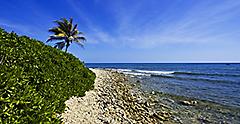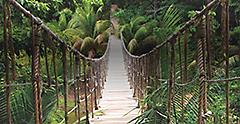The Best Western Caribbean Street Food
By Melissa Alvarado Sierra | Published on January 26, 2024
1. Jerk Chicken
Where To Get It: Pepper's Jerk Center in Falmouth, Jamaica
What It Is: This might be the most famous western Caribbean street food, and I couldn't wait to taste it. The first time I tried jerk chicken was in Falmouth, Jamaica on a cruise. I had been walking for less than five minutes after leaving the ship when I came across Pepper's Jerk Center. I learned that day that the origin of jerk chicken can be traced back to the indigenous Taino people, who perfected the technique of marinating meat with a blend of spices and slow-cooking it over a wood fire. Over time, African, European and Asian influences added depth and complexity to the recipe, creating the distinctive flavor that we recognize today and see available as Caribbean street food in places including Grand Cayman and Haiti.
The cook told me that the chicken is marinated for several hours, sometimes overnight, to allow the flavors to blend well. It is then grilled slowly over an open flame to give it a rich smokiness. The result is tender chicken with a slightly charred and crispy exterior, bursting with the flavors of the Caribbean. I enjoyed the chicken right next to an outdoor jerk pit, with the aroma enveloping my hair and clothes. A local woman next to me turned up the music in her boombox, and I realized I had never enjoyed chicken this much.
2. Tacos Al Pastor
Where To Get It: Los Sera's Tacos in Cozumel, Mexico
What It Is: Tacos al pastor, a Mexican masterpiece, holds a special place in my heart when it comes to western Caribbean street food. Originating in central Mexico, tacos al pastor have become iconic in places like Tulum, Cozumel and Costa Maya. I've traveled across Mexico looking for the best versions of this dish and have found some great iterations along the coast. The original recipe for tacos al pastor was created by Lebanese immigrants who shared their shawarma traditions with locals in Mexico in the early 20th century. This fusion resulted in a match made in gastronomic heaven: It consists of thin slices of marinated pork seasoned with a blend of spices including achiote, guajillo chili and garlic. The meat is then stacked onto a vertical spit, called a trompo, and slow-roasted until it's tender.
As the meat rotates, the outer layer caramelizes, forming crispy edges that add texture and smoky flavor. Each taco is filled with slices of pork and topped with pineapple, cilantro, onions and a splash of lime juice. One of the best I have had is at Los Sera's Tacos in Cozumel, just a 15-minute walk from the port. Their tacos are astonishing: The sweet, savory, tangy and spicy flavors dance in your mouth. If you've ever wondered what Caribbean street food is at its best, this is it.
3. Ceviche
Where To Get It: La Cevicheria in Roatán, Honduras
What It Is: This refreshing and vibrant dish, found in destinations like Belize and Roatán, serves as an antidote to the tropical climate. It's also known as "seviche" or "cebiche" and is a culinary art form that originated in the coastal regions of Latin America. It typically features raw fish or seafood, such as shrimp, lobster or snapper, marinated in lime or lemon juice. The acid in the juice basically "cooks" the seafood, turning it into a tender and tangy dish.
Each destination infuses ceviche with local ingredients and influences. My favorite is the Roatán ceviche, especially the one from La Cevicheria, less than a 20-minute drive from the ship. Don't leave without tasting the citrusy leche de tigre version.
4. Arepas And Pupusas
Where To Get It: Kory's Pupuseria in Belize City, Belize
What It Is: Arepas are one of my all-time favorite street foods, mainly because of their gooey goodness. Originally from Venezuela, this Caribbean food has found its way to many destinations, including Cozumel, Belize and Grand Cayman. Arepas are often served as sandwiches and come stuffed with lots of different things, such as chicken or pork, black beans, cheese and avocado.
In Belize, there's a similar dish called pupusas, which are typically flat and cooked on a griddle until the outer layer becomes crispy, creating a delightful contrast with the warm, soft filling inside. These versatile and flavorful discs of masa dough are cherished for their ability to adapt to various fillings, from savory to sweet. In Belize, I always stop by Kory's Pupuseria, just a four-minute drive from the cruise terminal, and order several of their delicious garlic and cheese pupusas to take with me as I explore the city.
5. Pan De Coco
Where To Get It: Panaderia Avila in Roatán, Honduras
What It Is: This dairy-free bread is made with coconut milk and grated coconut and shaped into little spheres that can be eaten for breakfast or as a snack. (I love them with coffee).
I tried pan de coco and other baked goods at Panaderia Avila, about a 26-minute drive from Roatán's cruise ship terminal. The pastries are baked fresh daily, and the sweet aroma fills this bakery enticing passersby, including myself. I bought a bag of their most popular pastries to take with me back to the cruise, and I suggest you do the same on your visit to Roatán.
Related Articles

Cruises are the Best Birthday Weekend Getaways | Royal Caribbean Cruises
READ MORE

7 Best Caribbean Vacations: Top Destination Spots And How To Get There | Royal Caribbean Cruises
READ MORE

Indonesian Food’s Global Influence | Royal Caribbean Cruises
READ MORE

Discover the Best Mexico Historical Sites and Mayan Ruins | Royal Caribbean Cruise
READ MORE











